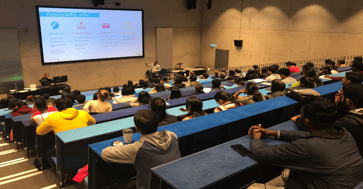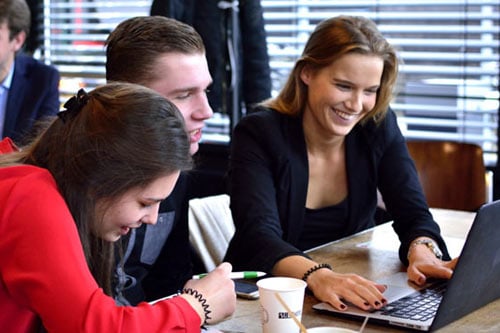Looking for the Laboratory
When it comes to improving student engagement, social sciences and humanities are at a disadvantage. Natural sciences, engineering, arts and computer science courses usually have time specifically timetabled for practical application of theory. In business-related subjects this is not traditionally the case. Case studies are usually the ‘go to’ for educators to bring a real world application to the learning and workshops around those case studies or impending coursework are a compliment. However they cannot compare to a student learning about air resistance then dropping a feather and a ball bearing to test the theory.
Getting students more engaged is a battle cry in all academic institutions. Educators know that if they are going to yield good results, they need to get their students more engaged with course content. The dynamic model of educational effectiveness (Creemers & Kyriakedes, 2006) cites a key characteristic of educators who are associated with high learning gains is managing time in class to maximise student engagement. Simply put, you have to manage time well if you are to increase the engagement of students. The relationship between engagement and achieving learning objectives is intuitive but there is a link between time management and academic achievement that is less obvious. The link between the two is the teacher and how they plan their time. Time management is often overlooked. It starts with the timetabling of rooms, staff and students. Modules are considered and then individual slots of time over the duration of the module. By the time consideration is given to how students will be engaged teachers are often already confined by content delivery and coursework deadlines.
engagement of students. The relationship between engagement and achieving learning objectives is intuitive but there is a link between time management and academic achievement that is less obvious. The link between the two is the teacher and how they plan their time. Time management is often overlooked. It starts with the timetabling of rooms, staff and students. Modules are considered and then individual slots of time over the duration of the module. By the time consideration is given to how students will be engaged teachers are often already confined by content delivery and coursework deadlines.
Case Studies, Business Simulations, Placements
Short of bending the laws of physics, educators cannot condense the application of business theories and concepts into a short enough time frame for students to have any meaningful engagement. The reason is that to test, for example, the simple theory that lowering the price of a product will increase the revenue a student would have to create a product, position it in a market and compete for sales volume amongst others trying to do the same. Even the best academic institutions in the world could not do this within the real world time constraints of a university course. The only way to create this level of engagement with the content of a business course is  through a business simulation or placement that accurately emulates the reality of business management and operations. However only the most self-motivated individuals will pro-actively pursue placements and they are difficult to integrate with the learning in school in a cohesive way for all students in the cohort. Effectively managing time to maximise engagement in business means giving students time to apply what they are learning to a controlled environment, like a lab for natural sciences or the art studio for an art student. The instructor's role is to provide the apparatus or the canvas with the theory and examples and then encourage engagement. The learning is then experiential. With business the equivalent is a business simulation. So the reason why students of business related subjects are disengaged is because it is much more challenging for academic institutions to give educators the opportunity to do so. The onus then falls on the individual educator who is even more limited due to administrative limitations on top of marking priorities and in some cases their own research.
through a business simulation or placement that accurately emulates the reality of business management and operations. However only the most self-motivated individuals will pro-actively pursue placements and they are difficult to integrate with the learning in school in a cohesive way for all students in the cohort. Effectively managing time to maximise engagement in business means giving students time to apply what they are learning to a controlled environment, like a lab for natural sciences or the art studio for an art student. The instructor's role is to provide the apparatus or the canvas with the theory and examples and then encourage engagement. The learning is then experiential. With business the equivalent is a business simulation. So the reason why students of business related subjects are disengaged is because it is much more challenging for academic institutions to give educators the opportunity to do so. The onus then falls on the individual educator who is even more limited due to administrative limitations on top of marking priorities and in some cases their own research.
Competing for attention - new student engagement issues
This is not to say that Universities and educators are the cause of increasing disengagement amongst students, indeed social trends are producing student intakes with ever shorter attention spans and lower motivation. From smart-phones to Covid there is plenty working against improving engagement in class. However with these changes on the student side universities cannot expect to maintain their academic standings without making corrective decisions, let alone improve academic standings.
INTERESTED IN USING BUSINESS SIMULATIONS?
Click on the button below to view our catalogue.
CASE STUDIES
Check out our library of case studies to see how our academic partners have used simulations in their teaching.
Citations
- Creemers, B. P. M., & Kyriakides, L. (2006). Critical Analysis of the Current Approaches to Modelling Educational Effectiveness: The importance of establishing a dynamic model. School Effectiveness and School Improvement, 17(3), 347-366. https://doi.org/10.1080/09243450600697242


.png?length=300&name=unnamed%20(11).png)
.png?length=300&name=unnamed%20(7).png)
.png?length=300&name=unnamed%20(8).png)
.png?length=300&name=unnamed%20(6).png)

.png?length=300&name=unnamed%20(10).png)
.png?length=300&name=unnamed%20(5).png)
.png?length=300&name=unnamed%20(9).png)
.png?length=300&name=unnamed%20(4).png)
.png?length=300&name=unnamed%20(2).png)
.png?length=300&name=unnamed%20(1).png)
.png?length=300&name=unnamed%20(3).png)
.jpg?length=300&name=unnamed%20(2).jpg)





.png?length=300&name=loughborough-university-logo%20(small).png)





